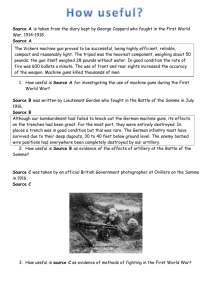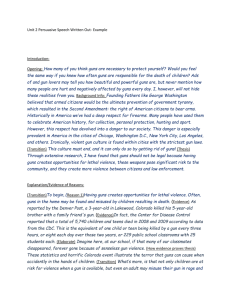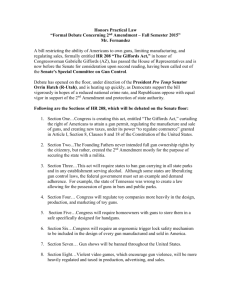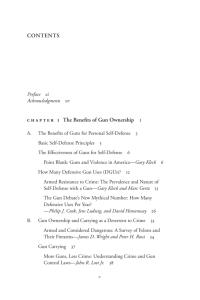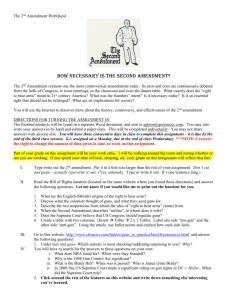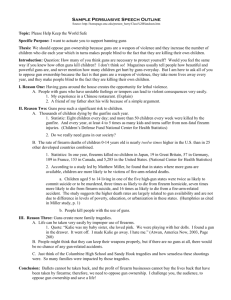Baltimore Business Journal
advertisement
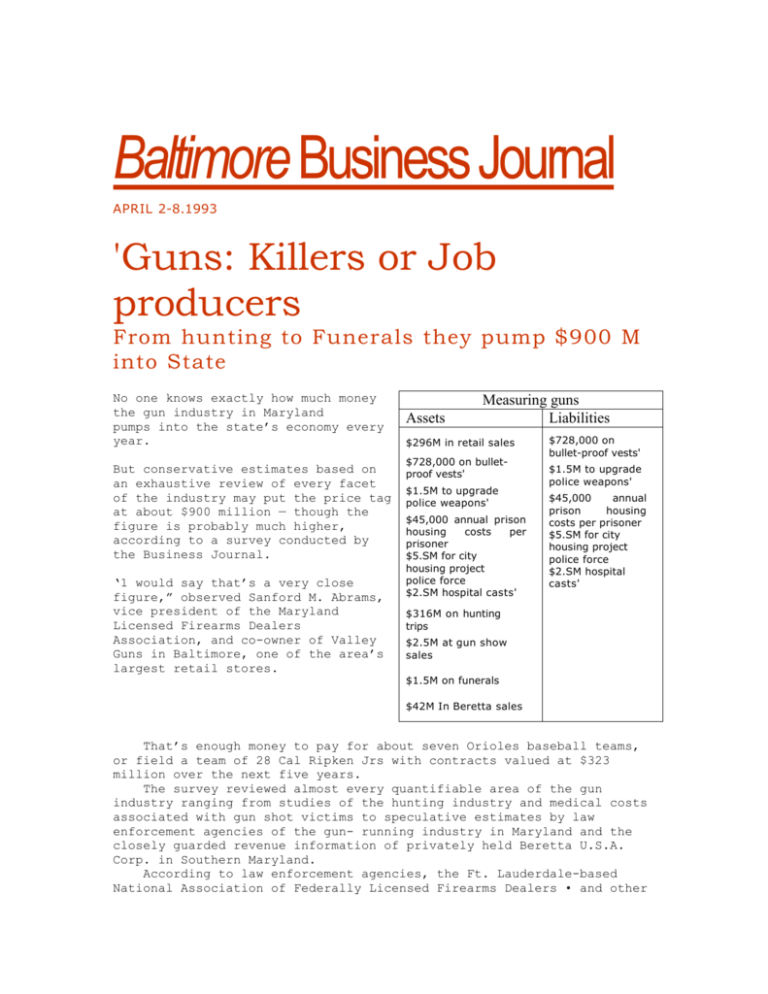
Baltimore Business Journal APRIL 2-8.1993 'Guns: Killers or Job producers From hunting to Funerals they pump $900 M into State No one knows exactly how much money the gun industry in Maryland pumps into the state’s economy every year. But conservative estimates based on an exhaustive review of every facet of the industry may put the price tag at about $900 million — though the figure is probably much higher, according to a survey conducted by the Business Journal. ‘1 would say that’s a very close figure,” observed Sanford M. Abrams, vice president of the Maryland Licensed Firearms Dealers Association, and co-owner of Valley Guns in Baltimore, one of the area’s largest retail stores. Assets Measuring guns Liabilities $296M in retail sales $728,000 on bulletproof vests' $1.5M to upgrade police weapons' $45,000 annual prison housing costs per prisoner $5.SM for city housing project police force $2.SM hospital casts' $728,000 on bullet-proof vests' $1.5M to upgrade police weapons' $45,000 annual prison housing costs per prisoner $5.SM for city housing project police force $2.SM hospital casts' $316M on hunting trips $2.5M at gun show sales $1.5M on funerals $42M In Beretta sales That’s enough money to pay for about seven Orioles baseball teams, or field a team of 28 Cal Ripken Jrs with contracts valued at $323 million over the next five years. The survey reviewed almost every quantifiable area of the gun industry ranging from studies of the hunting industry and medical costs associated with gun shot victims to speculative estimates by law enforcement agencies of the gun- running industry in Maryland and the closely guarded revenue information of privately held Beretta U.S.A. Corp. in Southern Maryland. According to law enforcement agencies, the Ft. Lauderdale-based National Association of Federally Licensed Firearms Dealers • and other industry sources, the biggest revenue generators in Maryland’s gun industry are as follows: Hunting. A 1985 study conducted by the state’s Department of Natural Resources found that hunters spent about $316.3 million (1992 dollars) for lodging and food, ammunition, gun licenses, stamps, tags, permits and other expenses related to hunting with fire’ arms. Gun dealers. Maryland’s stale and federally licensed gun dealers sell an estimated $296.92 million in guns annually, or about $5.71 million worth of handguns, pistols and rifles each week. And that doesn’t include the estimated 3114 million gun inventory already displayed under glass cases or hanging on the walls of more than 500 stores. Gun show admissions. About 500,000 customers attend gun shows in Maryland annually. They pay about $2.5 million to see and buy everything from Civil War-vintage muskets to the latest fashion in semi-automatic pistols. No one has a clue as to how many guns are purchased at these shows because they haven’t been regulated. Baretta. The Italian gunmaker has two factories in Maryland. The 480 employees at plants in Accokeek and Pocomoke City have a combined payroll of about $12 million. Based on monthly sales volume figures, industry observers believe that the company could have annual revenues of about $42 million in Maryland. But that figure should probably be several millions of dollars higher because the $42 million estimate is based on how much the federal government pays the company for firearms. That per unit price, in fact, is three times lower than what a consumer might pay for the same gun in a retail store. Funeral expenses. An estimated $1.59 million was spent to bury 376 Marylanders killed with firearms in 1991, according to police and funeral industry estimates on the average cost per funeral. Gunrunning. The U.S. Bureau of Alcohol, Tobacco and Firearms is just now beginning to conduct highly secretive probes of gunrunning in Baltimore and surrounding problem areas — most notably, Prince George’s County. A cache of some 32.06 million worth of guns was stolen in Maryland in 1991, the latest available figures reported by the stale police. ATF and police sources say it is virtually impossible to estimate how big this niche of the industry is. It’s difficult to detect so-called straw purchases’’ of guns by persons forbidden 10 buy them because of their criminal records. In addition, no one knows how many guns trade hands through national publications such as the Gun List or Shotgun News, where consumers can shop for anything ranging from a Chinese Tokareve handgun for $89 to FRG-2 sniper rifles for $5,900. The ATF is spending some $1 million in salaries and investigative resources on a 2-year-old first time-ever project in Baltimore called the “Achilles Group.” The special task force, which has been formed in 20 other major cities around the country, is looking at trace studies of guns recovered from violent crimes — mostly in the eastern district of the city, said Karl Stankovic, assistant special agent in charge of Baltimore’s newly opened ATF office. A preliminary study of some 1,300 guns recovered in violent crimes last year revealed about 46 percent came from federally licensed firearms dealers in Maryland, Stankovic said. And, he added, the majority of those guns came from six dealers: two in the city, three in Baltimore County and one in Anne Arundel County. “Maryland is the source for its illegal guns.’’ said Stankovic, who declined to identify the stores where guns were bought for use in violent crimes. The reverse trend appears to be the case with other states, according to a review of similar Bureau of Alcohol, Tobacco and Firearm gun tracing studies conducted in New York City and Washington, D.C. An ATF study conducted last year by field offices in those cities found that a quarter of the guns recovered in Washington had come from Maryland while a barely measurable number recovered in New York could be traced back to Maryland. A huge 40 percent of the New York guns had been shipped from neighboring Virginia where buying handguns is so easy that the slate had become an armory for criminals While the dollar value on illegal gun- running is difficult to quantify, the state has conducted a survey to assess the economic affects of hunting for deer and migratory waterfowl in the state. The state’s Department of Natural Resources found in 1985 that hunters spent about $316.39 million on duck stamps, hunting licenses, ammo, lodging, food and other gun-related expenses. “It has been really big business until recent years,” said Larry Hindman, director of Maryland’s migratory bird program. The sale of duck stamps by the state helps to improve wetlands where ducks and Canadian geese frequent during migratory season, he said. “If you were here in the heyday of goose hunting, we drew people from all over the world,” Hindman said. Editor’s comment: You’re blood is now boiling – how can the gun industry be so crass as to count the economic impact of funerals as a positive benefit? And why is this in a humor website? Check the date. April Fools!!!
